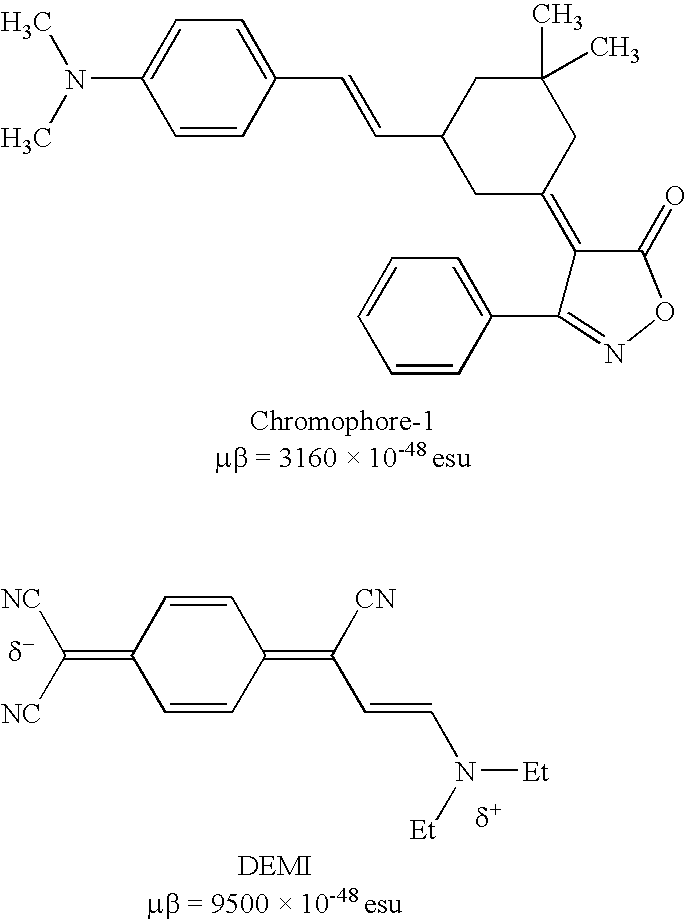Zwitterionic chromophores and polymers containing such chromophores
a chromophores and polymer technology, applied in the direction of styryl dyes, organic chemistry, metal/polymethine dyes, etc., can solve the problems of no practical value for electro-optical devices, large macroscopic nonlinearities,
- Summary
- Abstract
- Description
- Claims
- Application Information
AI Technical Summary
Problems solved by technology
Method used
Image
Examples
example 1
N-(3-hydroxypropyl)-4-picolinium bromide (Ib)
[0026]Anhydrous ethanol (250 mL) was added to a two-neck, 1 L round-bottomed flask, flushed with nitrogen, followed by addition of 3-bromo-1-propanol (60.0 g, 0.4317 mol) and 4-picoline (43.8 g, 0.4701 mol). The mixture was heated with stirring at 60° C. for 24 hours under nitrogen. The reaction was stopped and the contents in flask were transferred to a one-neck round-bottomed flask. The solvent was removed under vacuum leaving the product as a viscous, dark yellow-orange liquid. The product was washed within the same flask with diethyl ether (4×100 mL) and any remaining solvent was removed under vacuum. The yield of N-(3-hydroxypropyl)-4-picolinium bromide was 96.6 g (96% yield). 1H NMR (400 MHz, DMSO-d6): δ 8.98 (2H, d, J=6.8 Hz), 8.00 (2H, d, J=6.8 Hz), 4.64 (2H, t, J=7.0 Hz, 7.0 Hz), 3.44 (2H, t, J=6.0 Hz, 6.0 Hz), 2.62 (3H, s), 2.06 (2H, p, J=6.8 Hz, 6.0 Hz, 6.0 Hz, 6.8 Hz). IR (neat): 3332 cm−1 (O—H), 1642 cm−1 (>C═N—C), 1518 cm−1 ...
example 2
N-(2-hydroxyethyl)-4-picolinium bromide (Ia)
[0027]In a 3-neck, round-bottomed flask flushed with nitrogen, 2-bromo-1-ethanol (40.01 mmol), 4-picoline (43.57 mmol) and absolute ethanol (16 mL) were combined and heated for 3.5 hours at 50° C. under nitrogen with stirring. The reaction was stopped and the contents of the flask were transferred to a one-neck round-bottomed flask. The solvent was removed under vacuum and the residue was washed with diethyl ether (4×100 ml) and any remaining solvent was removed under vacuum. The product was obtained as a viscous orange liquid in a 34% yield. 1H NMR (200 MHz, CDCl3) 8.9 (2H, protons on pyridine ring), 8.0 (2H, protons on pyridine ring), 2.6 (3H, CH3), 4.6 (2H, —CH2O), 3.8 (2H, —NCH2—), 5.2 (1H, —OH); IR (neat, cm−1) 3303 (OH), 1640 (aromatic C═N), 1474 (aromatic C—C).
example 3
N-(6-hydoxyhexyl)-4-picolinium bromide (Ic)
[0028]6-Bromo-1-hexanol (27.61 mmol), 4-picoline (30.07 mmol) and absolute ethanol (16 mL) were added to a 3-neck, round-bottomed flask, and were heated at reflux The reaction was stopped after 36 hours. The solvent was removed under vacuum and the residue was washed with diethyl ether (4×100 ml), after which any remaining solvent was removed by vacuum. The product was obtained as an orange-yellow viscous liquid in a 100% yield. 1H NMR (400 MHz, DMSO-d6): δ 9.01 (2H, d, J=6.4 Hz), 8.02 (2H, d, J=6.4 Hz), 4.57 (2H, t, J=7.2 Hz, 7.2 Hz), 4.01 (1H, br), 3.37 (2H, t, J=6.4 Hz, 6.4 Hz), 2.26 (3H, s), 1.89 (2H, p, J=7.2 Hz, 7.2 Hz, 7.2 Hz, 7.2 Hz), 1.21-1.49 (6H, m).
PUM
| Property | Measurement | Unit |
|---|---|---|
| glass transition temperature | aaaaa | aaaaa |
| temperature | aaaaa | aaaaa |
| speed | aaaaa | aaaaa |
Abstract
Description
Claims
Application Information
 Login to View More
Login to View More - R&D
- Intellectual Property
- Life Sciences
- Materials
- Tech Scout
- Unparalleled Data Quality
- Higher Quality Content
- 60% Fewer Hallucinations
Browse by: Latest US Patents, China's latest patents, Technical Efficacy Thesaurus, Application Domain, Technology Topic, Popular Technical Reports.
© 2025 PatSnap. All rights reserved.Legal|Privacy policy|Modern Slavery Act Transparency Statement|Sitemap|About US| Contact US: help@patsnap.com



